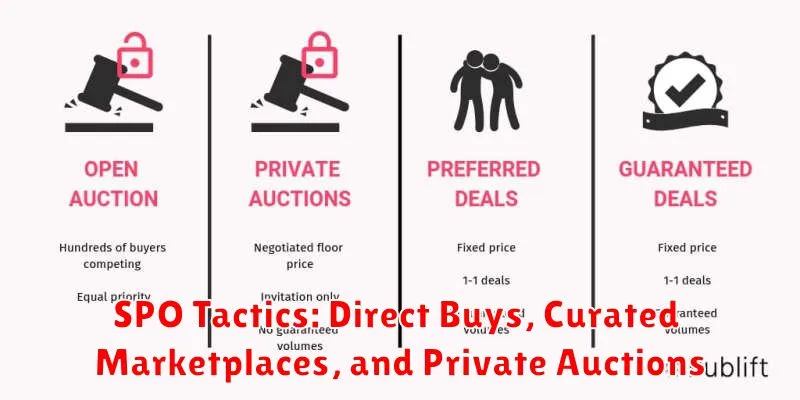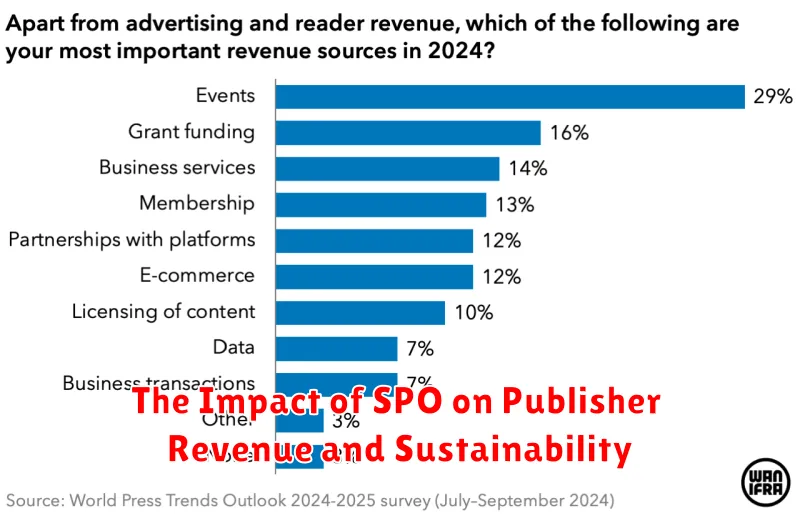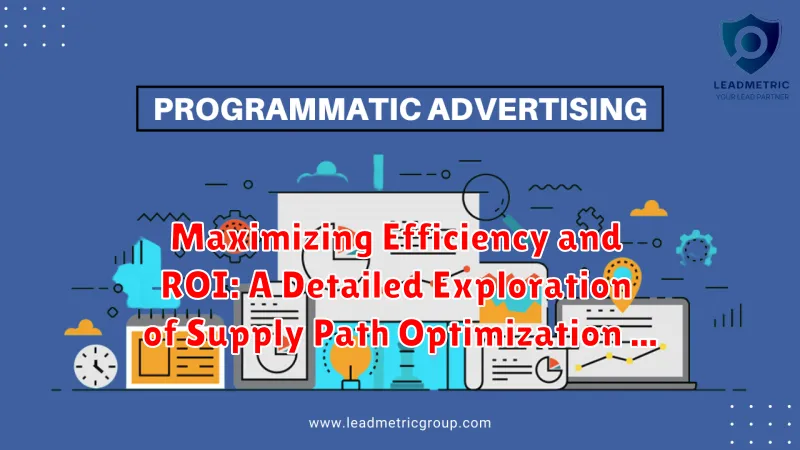In today’s dynamic digital advertising landscape, achieving maximum efficiency and a strong return on investment (ROI) is paramount. This article delves into the critical realm of Supply Path Optimization (SPO), a strategic approach designed to streamline the programmatic advertising supply chain. By strategically selecting the most direct and effective routes to reach target audiences, SPO empowers advertisers to reduce costs, increase transparency, and ultimately, improve campaign performance across various channels globally. Understanding and implementing a robust SPO strategy is no longer a luxury, but a necessity for any organization seeking to thrive in the competitive digital marketplace.
This detailed exploration of Supply Path Optimization will provide a comprehensive overview of its core principles, benefits, and practical implementation strategies. We will examine how SPO can minimize intermediary fees, combat ad fraud, and enhance control over ad placements. Furthermore, this guide will address the common challenges associated with SPO adoption and offer actionable insights for optimizing your supply path for enhanced efficiency and a substantial boost to your ROI. Whether you are a seasoned digital marketer or new to the programmatic landscape, this article serves as a valuable resource for mastering the art of SPO.
What is Supply Path Optimization (SPO) and Why Does it Matter?
Supply Path Optimization (SPO) is a strategic approach within programmatic advertising that aims to identify and utilize the most efficient and direct routes to connect advertisers with publishers. It involves analyzing the various paths an ad impression can take, identifying redundant intermediaries, and streamlining the process to reduce costs and improve transparency.
The “supply path” refers to the chain of entities involved in delivering an ad, including supply-side platforms (SSPs), ad exchanges, and other technology vendors. SPO seeks to minimize hops within this supply chain, resulting in lower fees and a greater portion of the advertising budget reaching the publisher.
SPO matters because it directly impacts both advertisers’ return on investment (ROI) and publishers’ revenue. By optimizing the supply path, advertisers can achieve:
- Reduced Costs: Eliminating unnecessary intermediaries lowers overall advertising expenses.
- Increased Transparency: Gain clearer visibility into where ad dollars are going.
- Improved Efficiency: Streamlined processes lead to faster and more effective campaigns.
- Better Control: Advertisers have more say in where their ads appear and the quality of the inventory.
Ultimately, SPO fosters a more sustainable and efficient programmatic ecosystem for all participants.
Understanding the Complexities of the Programmatic Supply Chain
The programmatic supply chain, the automated system responsible for buying and selling digital advertising, is inherently complex. It involves numerous intermediaries, each taking a fraction of the advertising dollar. This intricate web can obscure the true value and efficiency of ad spending.
Several key entities play crucial roles within this ecosystem:
- Advertisers: Seek to reach target audiences with their marketing messages.
- Demand-Side Platforms (DSPs): Enable advertisers to manage and optimize their ad campaigns.
- Supply-Side Platforms (SSPs): Allow publishers to manage and sell their ad inventory.
- Ad Exchanges: Facilitate real-time auctions between DSPs and SSPs.
- Data Management Platforms (DMPs): Collect and manage audience data to improve targeting.
Understanding how these components interact is essential for advertisers seeking to optimize their return on investment and publishers striving for fair revenue.
The Benefits of SPO for Advertisers: Transparency, Efficiency, and Cost Savings
Supply Path Optimization (SPO) offers significant advantages for advertisers seeking to enhance the effectiveness of their programmatic advertising campaigns. The core benefits revolve around increased transparency, improved efficiency, and substantial cost savings.
Increased transparency allows advertisers to gain a clear understanding of where their ad spend is going and which intermediaries are involved in the ad delivery process. This visibility enables informed decision-making and helps identify potential sources of wasted ad dollars.
Improved efficiency stems from streamlining the supply chain, reducing the number of hops between the advertiser and the publisher. This shorter, more direct path minimizes latency and ensures that ads are delivered quickly and effectively to the intended audience. Reduced latency also has impact to user experience, particularly in video.
Cost savings are a direct result of increased transparency and efficiency. By eliminating unnecessary intermediaries and optimizing the supply path, advertisers can reduce ad tech tax and redirect those funds towards reaching more consumers.
Key Strategies for Implementing Effective SPO
Implementing effective Supply Path Optimization (SPO) requires a strategic and multifaceted approach. Several key strategies can significantly enhance efficiency and Return on Investment (ROI).
Prioritize Transparency and Auditing
Establish clear lines of sight into the programmatic supply chain. Regularly audit your supply paths to identify redundancies and hidden costs. This involves using tools and technologies that provide detailed reporting on each transaction.
Consolidate Supply Partners
Reduce the number of intermediaries involved in your ad buying process. Fewer hops mean less opportunity for margin stacking and increased efficiency. Focus on building direct relationships with key publishers and platforms.
Leverage Data-Driven Decision Making
Use data analytics to identify the most efficient and cost-effective supply paths. Analyze performance data to understand which partners are delivering the best results and prioritize those relationships. Employ Key Performance Indicators (KPIs) to monitor progress and make data-backed adjustments.
The Role of Data and Analytics in Supply Path Optimization
Data and analytics are crucial components of effective Supply Path Optimization (SPO). SPO initiatives rely heavily on the ability to analyze vast datasets to identify inefficiencies and opportunities for improvement within the programmatic supply chain.
Data-driven insights enable advertisers to understand the performance of different supply paths, assess the quality of inventory, and identify potential sources of fraud or waste. By analyzing key metrics such as viewability, completion rates, and cost per acquisition (CPA), advertisers can make informed decisions about which supply paths to prioritize.
Analytics platforms and tools provide the means to visualize and interpret this data, enabling advertisers to optimize their campaigns in real-time. The use of machine learning algorithms can further enhance SPO efforts by automating the identification of patterns and anomalies in the data, ultimately leading to improved efficiency and ROI.
SPO Tactics: Direct Buys, Curated Marketplaces, and Private Auctions

Supply Path Optimization (SPO) encompasses various tactics to streamline the programmatic supply chain. These tactics aim to enhance transparency, reduce costs, and improve overall efficiency.
Direct Buys
Direct buys involve establishing direct relationships between advertisers and publishers, bypassing intermediaries. This approach often leads to more transparent pricing and greater control over inventory.
Curated Marketplaces
Curated marketplaces offer a selected inventory of high-quality publishers, pre-vetted for brand safety and performance. Advertisers benefit from access to premium inventory with reduced risk.
Private Auctions (PMPs)
Private Auctions (PMPs) provide advertisers with exclusive access to premium publisher inventory through invite-only auctions. PMPs allow for precise targeting and greater control over bidding.
Measuring the Impact of SPO: Key Performance Indicators (KPIs)
Establishing clear Key Performance Indicators (KPIs) is crucial for evaluating the effectiveness of Supply Path Optimization (SPO) initiatives. These metrics provide tangible insights into the ROI and efficiency gains achieved through SPO.
Key KPIs to Track:
- Cost per Mille (CPM): Track reductions in CPM across optimized supply paths.
- Viewability Rates: Monitor improvements in ad viewability as a result of SPO.
- Fraud Reduction: Measure the decrease in fraudulent impressions and clicks.
- Working Media Spend: Assess the percentage of ad spend that directly contributes to media exposure, minimizing intermediary fees.
- Return on Ad Spend (ROAS): Analyze the increase in revenue generated per dollar spent on advertising.
By consistently monitoring these KPIs, advertisers can gain a comprehensive understanding of SPO’s impact and make data-driven decisions to further optimize their supply chain.
Overcoming Challenges in Supply Path Optimization
While Supply Path Optimization (SPO) offers significant advantages, its implementation is not without challenges. One primary hurdle is the lack of transparency in the programmatic supply chain. Identifying all intermediaries and their associated costs can be difficult, hindering accurate path assessment.
Another challenge lies in data discrepancies. Inconsistent reporting across different platforms can lead to inaccurate measurement of SPO effectiveness. Data standardization and validation are crucial for reliable analysis.
Furthermore, internal alignment is essential. Successful SPO requires collaboration between different teams within an organization, including media buying, data analytics, and finance. Resistance to change and a lack of understanding of SPO principles can impede progress.
Finally, maintaining publisher relationships is critical. Aggressively cutting out intermediaries can potentially damage relationships with valuable publishers. A balanced approach that considers both efficiency and publisher sustainability is necessary.
The Impact of SPO on Publisher Revenue and Sustainability

Supply Path Optimization (SPO)‘s effects on publishers are multifaceted, influencing both their revenue streams and long-term sustainability. While primarily driven by advertiser demands for efficiency, SPO also presents opportunities and challenges for publishers.
On one hand, SPO can streamline the programmatic ecosystem, leading to increased revenue for publishers who offer high-quality inventory and direct connections to advertisers. By reducing the number of intermediaries and associated fees, more revenue can flow directly to the publisher.
However, SPO can also put pressure on publishers who rely on indirect sales channels or those with less desirable inventory. Transparency in the supply chain exposes inefficient or low-value paths, potentially impacting revenue for publishers who have historically benefited from these channels. This necessitates a focus on inventory quality, viewability, and brand safety to remain competitive.
Ultimately, successful navigation of SPO requires publishers to adapt their strategies, focusing on building direct relationships with advertisers, optimizing inventory, and demonstrating the value of their audience. This approach ensures both revenue generation and long-term sustainability in an evolving programmatic landscape.
The Future of Supply Path Optimization: Trends and Predictions
The landscape of Supply Path Optimization (SPO) is poised for significant evolution, driven by technological advancements and shifting industry dynamics. We anticipate a greater emphasis on AI-powered optimization, allowing for more granular and real-time adjustments to supply paths.
Transparency will become even more critical, with advertisers demanding greater visibility into the fees and intermediaries involved in programmatic transactions. This will likely lead to the adoption of standardized protocols and increased use of blockchain technology for verification.
Furthermore, we foresee the rise of dynamic SPO, where optimization strategies adapt automatically based on performance data and market conditions. This will require sophisticated analytics and a deeper understanding of the nuances of the programmatic ecosystem.
Finally, the lines between traditional and programmatic advertising may continue to blur, influencing SPO strategies to encompass a broader range of media channels and buying methods. Expect continued innovation in this dynamic field as advertisers seek greater efficiency and return on investment (ROI).

